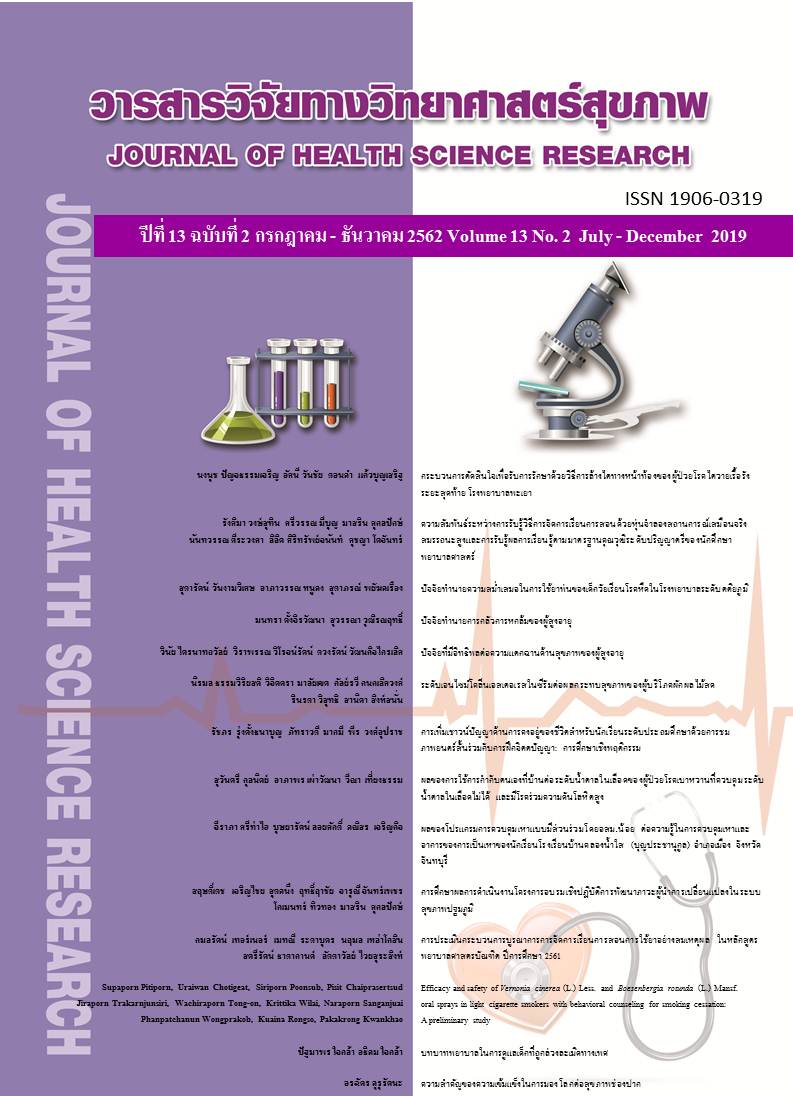ผลของการใช้การกำกับตนเองที่บ้านต่อระดับน้ำตาลในเลือดของผู้ป่วยโรคเบาหวาน ที่ควบคุมระดับน้ำตาลในเลือดไม่ได้ และมีโรคร่วมความดันโลหิตสูง
Main Article Content
บทคัดย่อ
โรคเบาหวานเป็นปัญหาสาธารณสุขที่สำคัญในหลายประเทศ ในประเทศไทยพบว่า อัตราตายด้วยโรคเบาหวานเพิ่มขึ้นทุกปี โดยเฉพาะระดับน้ำตาลในเลือดสูงที่เกิดร่วมกับความดันโลหิตสูงจะเพิ่มความถี่ของภาวะแทรกซ้อนจากโรคเบาหวานและโรคหลอดเลือดสมอง การวิจัยกึ่งทดลองนี้มีจุดมุ่งหมายเพื่อศึกษาผลของการใช้การกำกับตนเองที่บ้านต่อระดับน้ำตาลในเลือดของผู้ป่วยโรคเบาหวานที่ควบคุมระดับน้ำตาลในเลือดไม่ได้และมีโรคร่วมความดันโลหิตสูง กลุ่มเข้าร่วมโปรแกรม กลุ่มละ 30 คนจะได้รับการใช้การกำกับตนเองที่บ้านโดยประยุกต์ใช้แนวคิดการกำกับตนเองร่วมกับการดูแลสุขภาพที่บ้าน เครื่องมือที่ใช้ ประกอบด้วย แบบสอบถามพฤติกรรมการรับประทานอาหาร การออกกำลังกาย และการใช้ยาเบาหวาน เก็บรวบรวมข้อมูลโดยการวัดค่าระดับน้ำตาลในเลือดและให้กลุ่มตัวอย่างตอบแบบสอบถาม ดำเนินการเก็บข้อมูล 3 ระยะ คือ ก่อนเข้าร่วมโปรแกรม หลังเข้าร่วมโปรแกรม และระยะติดตามผล 4 สัปดาห์ วิเคราะห์ข้อมูลโดยใช้สถิติ Chi-square test, Wilcoxon signed-ranks test, Mann-Whitney U test, Independent t-test และ Repeated measure ANOVA
ผลการวิจัยพบว่า ภายหลังได้รับโปรแกรม กลุ่มเข้าร่วมโปรแกรมมีคะแนนเฉลี่ยพฤติกรรมการรับประทานอาหาร การออกกำลังกาย และการใช้ยาเบาหวาน สูงกว่ากลุ่มเปรียบเทียบอย่างมีนัยสำคัญทางสถิติ (p<.05) ค่าเฉลี่ยระดับน้ำตาลในเลือดของกลุ่มเข้าร่วมโปรแกรมต่ำกว่าก่อนเข้าร่วมโปรแกรมและต่ำกว่ากลุ่มเปรียบเทียบอย่างมีนัยสำคัญทางสถิติ (p<.05)
Article Details
บทความที่ได้รับการตีพิมพ์เป็นลิขสิทธิ์ของวิทยาลัยพยาบาลบรมราชชนนี จังหวัดนนทบุรี
ข้อความที่ปรากฏในบทความแต่ละเรื่องในวารสารวิชาการเล่มนี้เป็นความคิดเห็นส่วนตัวของผู้เขียนแต่ละท่านไม่เกี่ยวข้องกับวิทยาลัยพยาบาลบรมราชชนนี จังหวัดนนทบุรี และคณาจารย์ท่านอื่น ในวิทยาลัยฯ แต่อย่างใด ความรับผิดชอบองค์ประกอบทั้งหมดของบทความแต่ละเรื่องเป็นของผู้เขียนแต่ละท่าน หากมีความผิดพลาดใด ๆ ผู้เขียนแต่ละท่านจะรับผิดชอบบทความของตนเองแต่ผู้เดียว
References
2. Health Systems Development Group, Bureau of Non Communicable Diseases, Department of Disease Control. World Diabetes Day Campaign in 2016 [Internet]. 2016 [cited 2017 May 20]; Available from: http://www.thaincd.com/2016/ news/hot-news-detail.php? (in Thai).
3. Wannaseang S. The problem of diabetes in Thailand. In: Nitiyanant W, Wannaseang S, Deerochanawong C, editors. Diabetes situation in Thailand. Bangkok: Diabetes Association of Thailand; 2007. p. 81-4. (in Thai).
4. Sakunkeaw E. 5th Severe disease destroy Thai people: No. 4 Stroke. Bangkok: Kaimor Publisher; 2008. (in Thai).
5. Diabetes Clinic, Public Health Center 39 Rat Burana.Chronic disease registration. Bangkok: Public Health Center 39 Ratburana; 2018. (in Thai).
6. Intarakamhang U. Health behavior modification 3 self by the principle of PROMISE Model. Bangkok: Sukhumvit Printing; 2009. (in Thai).
7. Bandura A, National Institute of Mental Health. Social foundations of thought and action: a social cognitive theory. Englewood Cliffs, NJ: Prentice-Hall; 1986.
8. Public Health Nursing Division, Health Department, Bangkok Metropolitan Administration. Home health care guidelines (Home Health Care). Nonthaburi: HR Print and Training; 2012. (in Thai).
9. Sirsathitnatakun B. Research methodology in nursing. 4thed. Bangkok: U&I Intermedia; 2007. (in Thai).
10. Seangsuwan S, Asawachaisuwikrom W, Homsin P. Effect of self-regulation with clinical information program on eating behavior and blood sugar level among uncontrolled diabetes patients. The Journal of Faculty of Nursing Burapa University. 2011;19(3):54-64. (in Thai).
11. Polit DF, Beck CT. Nursing research: Principles and methods. 7th ed. Philadelphia: Lippincott, Williams & Wilkins; 2004.
2. Boonkaew N, Jitramontree N, Wirojratana V. The relationship between intrinsic motivation and glycemic control behaviors among older persons with type 2 diabetes. Nursing Journal. 2013;42 Suppl:84-94. (in Thai).
13. Baiphimai J, Leelukkanaveera Y, Srisuriyawet R. The effects of self-regulation by clinical information program to glycemic control behaviors score and glycoside hemoglobin level on uncontrolled type 2 diabetes. Journal of Public Health Nursing. 2018;31(3):123-44. (in Thai).

